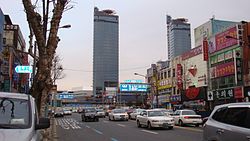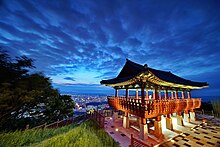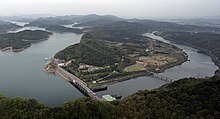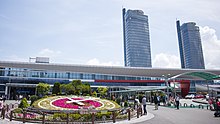Dong District, Daejeon
Dong 동구 | |
|---|---|
| Korean transcription(s) | |
| • Hanja | 東區 |
| • Revised Romanization | Dong-gu |
| • McCune–Reischauer | Tong-gu |
 | |
 | |
| Country | South Korea |
| Region | Hoseo |
| Provincial level | Daejeon |
| Administrative divisions | 16 administrative dong |
| Government | |
| • Mayor | Park Hee-jo(박희조) |
| Area | |
• Total | 136.61 km2 (52.75 sq mi) |
| Population (2024[1]) | |
• Total | 218,640 |
| • Density | 1,600/km2 (4,100/sq mi) |
| • Dialect | Chungcheong |
| Website | Dong District Office |
Dong District (Korean: 동구; RR: Dong-gu) is a district in Daejeon, South Korea. Dong-gu consists of a total of 16 dongs, including Yongun-dong, Hyo-dong, and Sannae-dong.[2]
To the east, the district borders Okcheon, Daedeok District, and Jung District. To the south, it borders Geumsan, South Chungcheong Province, and to the north, it borders Cheongwon and northern Okcheon.[3]
Tourism
Sikjangsan

Sikjangsan Mountain (Korean: 식장산) is 596.7m above sea level and has an 11.2 km walking trail. There are traditional temples such as Gujeolsa Temple and Gosansa Temple. The city designated Secheon Park, which contains many ruins of Sikjangsan Mountain, as a natural habitat conservation forest.[4]
Daecheongho Lake

Daecheongho Lake (Korean: 대청호) is an artificial lake created by damming the Geumgang with Daecheong Dam and is the third largest lake in South Korea. In particular, there are migratory birds and egrets due to the clean natural environment. Daecheong Lake's Hoeinseon Cherry Blossom Road is a 26.6 km long cherry blossom road. It is one of the beautiful cherry blossom roads selected by the Korea National Arboretum.[5]
Jungang Market

Daejeon Jungang Market (Korean: 대전 중앙시장), located near Daejeon Station, was the largest traditional market in the central region. There are themed streets within the market, examples of which include Bookstore Street, Fish Market Street, Tableware Wholesale Street, Accessory Street, Home Interior Street, and Food Street.[6]
Economy
Dong District (Dong-gu) is often regarded as the most underdeveloped area in Daejeon. However, it wasn’t always this way—Dong-gu once served as the central hub of the city. Its decline began in the 1990s, when the western areas of Daejeon, such as Seo-gu and Yuseong-gu, underwent significant development. The construction of the Dunsan New Town, along with the relocation of the Daejeon Government Complex and other key government offices, public institutions, businesses, and shops to this area, led to the gradual decline of Dong-gu, which had previously been the city’s original downtown.
Transportation


See also
References
- ^ "Population statistics". Korea Ministry of the Interior and Safety. 2024.
- ^ 대전광역시 동구청. www.donggu.go.kr (in Korean). Retrieved 2023-04-08.
- ^ "About Dong-gu – Facts". Daejeon Dong-gu District.
- ^ "Culture & Tourism – Attractions of Dong-gu – Mt. Sikjangsan". Daejeon Dong-gu District.
- ^ "Culture & Tourism – Attractions of Dong-gu – Daecheongho Lake". Daejeon Dong-gu District.
- ^ "Culture & Tourism – Attractions of Dong-gu – Jungang Market". Daejeon Jung-gu District.
External links
36°20′N 127°26′E / 36.33°N 127.43°E

